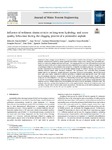Influence of sediment characteristics on long-term hydrology and water quality behaviour during the clogging process of a permeable asphalt

Use este enlace para citar
http://hdl.handle.net/2183/33126
A non ser que se indique outra cousa, a licenza do ítem descríbese como Atribución-NoComercial-SinDerivadas 3.0 España
Coleccións
- CITEEC-GEAMA - Artigos [110]
Metadatos
Mostrar o rexistro completo do ítemTítulo
Influence of sediment characteristics on long-term hydrology and water quality behaviour during the clogging process of a permeable asphaltAutor(es)
Data
2023Cita bibliográfica
García-Haba, E., Naves, J., Hernández-Crespo, C., Goya-Heredia, A., Suárez-López, J., Anta, J., Andrés-Doménech, I. (2023). Influence of sediment characteristics on long-term hydrology and water quality behaviour during the clogging process of a permeable asphalt. Journal of Water Process Engineering, 53, 103658. https://doi.org/10.1016/j.jwpe.2023.103658
Resumo
[Abstract:] Sustainable urban drainage systems (SUDS) are common solution to address flow discharges, runoff volumes and pollutant concentrations caused by urban expansion and climate change trend. Among them, permeable pavements (PP) effectively manage and treat stormwater. The clogging process of PP has been addressed in previous studies but there is still room for improvement the knowledge about how it affects to their performance in terms of hydrological behaviour and pollutant removal and how it depends on sediment properties. The present study simulates and analyses the behaviour of a permeable asphalt through 47 sediment loading steps tested for six different sediment classes under laboratory conditions. The experiments were performed using permeable asphalt slabs in two laboratory rainfall simulators, measuring reductions in permeability, filtered and runoff flows, and water quality variations in effluents according to sediment loads and rainfall events. The results showed significant reductions of permeability (22–99 %) for sediment surface loads from 1 kg/m2 onwards, except for very fine sediments (<125 μm) (1 %). Permeability recovery after vacuum cleaning varied between 8 % and 100 % of original permeability. Sediment particle size distribution, organic matter content and rain events sequence were key variables influencing the permeability loss and its recovery, and quality of filtrated water. The hydraulic efficiency was high, filtrating almost 100 % of the applied rainfall, whenever the sediment surface load was below 4 kg/m2, above which surface runoff was produced. The efficiency of the slab for pollutant retention was 96 % for COD, 76 % for TN, 79 % for TP, and 98 % for TSS.
Palabras chave
Permeable pavement
Sustainable urban drainage systems
SUDS
Runoff pollution
Rainfall simulation
Sustainable urban drainage systems
SUDS
Runoff pollution
Rainfall simulation
Versión do editor
Dereitos
Atribución-NoComercial-SinDerivadas 3.0 España






